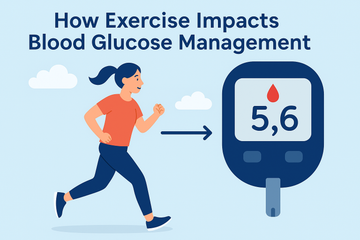How Exercise Impacts Blood Glucose Management

Managing blood glucose levels is essential for overall health, especially for individuals living with diabetes. While medication and nutrition play major roles, exercise is a highly effective, often underutilized tool for regulating blood sugar levels. Whether you're going for a walk, doing strength training, or taking a yoga class, physical activity significantly affects how your body uses glucose.
What Happens During Exercise?
When you exercise, your muscles require more energy. Your body meets this need by pulling glucose (sugar) from your bloodstream, which naturally lowers your blood sugar levels. At the same time, exercise increases your sensitivity to insulin, the hormone responsible for moving glucose into your cells.
Here’s what this means:
-
Your muscles absorb more glucose during and after physical activity.
-
Your body becomes more efficient at using insulin.
-
Blood sugar levels may drop and stay lower for several hours after exercise.
Types of Exercise and Their Effects
Aerobic Exercise (e.g., walking, jogging, cycling)
-
Increases heart rate and improves insulin sensitivity.
-
Helps lower blood glucose levels quickly.
Resistance Training (e.g., weightlifting, resistance bands)
-
Builds muscle mass, allowing your body to store more glucose efficiently.
-
Contributes to long-term blood sugar control.
Flexibility and Balance Exercises (e.g., yoga, stretching)
-
May not directly impact blood sugar levels, but they reduce stress and improve overall well-being.
-
Can help support blood sugar stability over time.
Why Exercise Matters for People with Diabetes
For individuals with type 2 diabetes, regular physical activity can significantly reduce blood glucose levels and improve insulin resistance. In some cases, it may even lead to reduced dependence on medication.
For those with type 1 diabetes, exercise also offers important health benefits, though it requires careful planning to avoid low blood sugar episodes (hypoglycemia). Benefits include:
-
Improved heart and lung health
-
Better mental clarity and mood
-
Enhanced energy levels
Practical Tips for Safe Exercise
-
Check your blood sugar levels before and after workouts.
-
Stay hydrated to support proper glucose regulation.
-
Carry a quick source of carbohydrates in case your blood sugar drops.
-
Start with low-intensity activities and gradually increase intensity and duration.
Long-Term Benefits
Research consistently shows that as little as 30 minutes of moderate activity most days of the week can improve blood glucose control. Over time, this can lead to:
-
Lower A1C levels
-
Reduced risk of diabetes complications
-
Improved weight management
-
Better quality of life
Conclusion
Exercise isn’t just a fitness strategy—it’s a powerful way to manage blood glucose levels and support long-term health. Whether you’re newly diagnosed or just looking to improve your habits, incorporating regular physical activity into your routine can make a significant difference.







